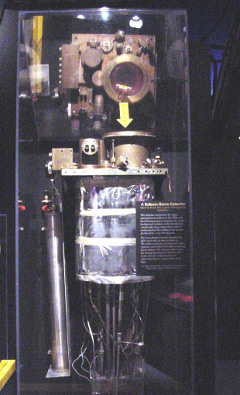Far-Infrared Spectrometer: The balloon-born Woody-Richards experiment, which was one of the first projects designed to measure the cosmic microwave background. The experiment was flown three times in the 1970s, and the results provided data on the thermal characteristics of the cosmic background radiation.
Credit: Courtesy the Smithsonian National Air and Space Museum
I went to the University of California,Berkeley, for graduate school, which was a transition from a very small school to a very big one. When I got there I still wanted to work on elementary particles, but after a couple of years of taking courses, I was tired of going to the library and thinking. I wanted to do something in the lab with my hands. I went around and interviewed with some people who might have interesting projects for me to work on, and I found this group with Paul Richards, Charles Townes, and Mike Werner. They were just beginning to try to measure the cosmic microwave background radiation (CMBR), the heat produced at the beginning of time that still fills the Universe.
This was just five years after the CMBR had been discovered, so it was a good problem for students to work on. I ended up working on an apparatus to measure the CMBR for my student project. The CMBR is bright enough to detect in the proper environment. If you put out a square-meter collector, you’ll get only three microwatts of heat from it. Unfortunately, you will also get 300 watts of heat from the Earth, which makes it pretty hard to measure the CMBR accurately from the ground. That's like seeing a flame from a match next to a bonfire.
Basically, my project was to get a cold apparatus up above the Earth’s warm and largely opaque atmosphere so you could measure the CMBR better, and we used infrared techniques to do this. Infrared techniques involve detectors that sense heat. We were using infrared technology to measure cosmic microwaves because that is the equipment that we had and it turned out to be useful for our purposes. We used bolometers as detectors. They pick up light energy at every wavelength – from high energy X-rays, to visible light, to radio waves. They are basically thermometers that measure the heat produced when light hits something. The more light that shines on them, the warmer they get, and the higher the temperature they show. In those days, that was the only technology available to us for this kind of experiment.
We built a balloon-borne instrument for my project. It failed even though I had done some previously successful work on a ground-based version of it. The failure was of a mechanical nature: we had not tested some mechanisms thoroughly enough. One of my colleagues, David Woody, a member of the research group with which I worked, was able to correct the errors with the equipment and succeeded in making the measurements we were trying for, but only after I left Berkeley. As it turned out, the backgrounds still limited our ability to test the cosmic origin of the radiation.


